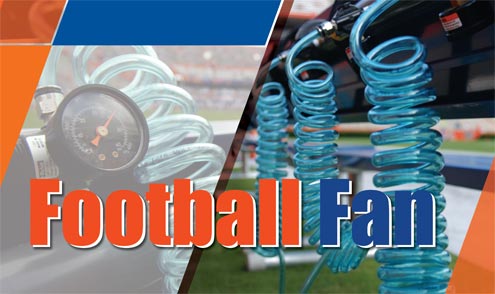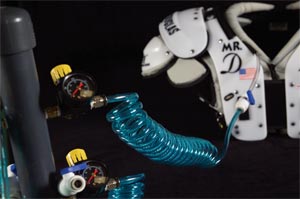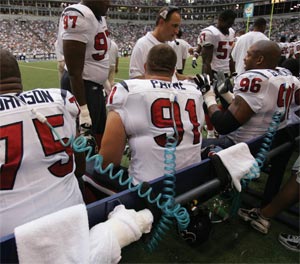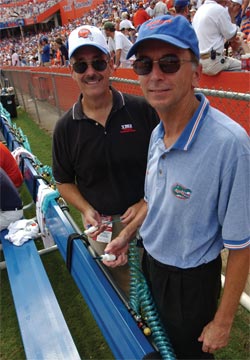|
|

For 15 years, Bill Bates suffered in the 90-degree heat of Texas Stadium. An all-pro safety for the Dallas Cowboys, Bates often needed intravenous fluids during and after games. On several occasions when he failed to get an IV after the game, he vomited on the side of the road on his way home. So when he tried on air-cooled Temperature Management System, or TMS, shoulder pads for the first time, Bates was shocked. “It was like ‘Oh my gosh, where was this when I was playing?’” Nikolaus Gravenstein, one of the University of Florida researchers who came up with the idea for the pads, says “I don’t know a single player who has tried it who hasn’t had some exclamation of surprise.” Gravenstein says it’s no surprise that hundreds of football players — from high school to the pros — suffer heat-related illness every year and that more than 20 have died over the last decade, given the insulating effects of football equipment on the body. The worst type of heat-related illness is heat stroke, when the sweating mechanism fails and the body is unable to cool down. Symptoms may include confusion, strong rapid pulse, dry flushed skin, lack of sweating, possible delirium or coma. The American College of Sports Medicine released new guidelines in August that cited the uniform as a key contributor to heat stress. "The reason players are perspiring so much is because their heat loss is so inefficient," says Gravenstein, who cites research by exercise scientists Larry Kenney of Penn State and Elizabeth McCullough of Kansas State which found that playing football in a full uniform is akin to playing in a men's three-piece wool suit. Gravenstein says that once his team -- which included anesthesiology Professor Sem Lampotang, a UF premedical student Dasia Esener and orthopaedic resident and former UF football player Michael Gilmore -- understood the insulating effects of the football uniform, preventing warm air and perspiration from escaping and cool air from penetrating, they asked "Why not just blow cold air under the uniform?" So they found some perforated tubing and inserted it into a set of shoulder pads.
“In a 100-percent humidity environment most of a player’s sweat is dripping away in liquid form, doing little to help him cool down. Under the pads, sweat cannot evaporate because the air space below the pads is already fully loaded with water vapor and stagnant,” says Lampotang, who has a doctorate in mechanical engineering. “In our system, we create a cool, dry and breezy microclimate under the pads that speeds the evaporation of sweat, absorbing a lot of heat with it.” Adds Gravenstein: “When you don’t have to sweat so much, you’re not so dehydrated, so you’re not so vulnerable to heat illness.” To get some hard data, the researchers used a 15-gallon water jug to simulate a player’s chest. They warmed the water in the jug to about 105 degrees Fahrenheit, then measured how long it took to cool off without pads, with regular pads and with 60-degree air-cooled pads. “The heat-transfer rate of air-cooled pads was 1.75 times that of regular pads,” said Gravenstein, “and almost certainly would have been higher with colder, higher-pressure air.” Despite their promising results, former UF football trainer Chris Patrick cautioned the researchers that the biggest challenge to such a system was its impact on the flow of the game or practice. Patrick referred Gravenstein to Fred Williams, whose Williams Sports Group in Jacksonville has been selling the popular Douglas football pads to the Gators and many other teams for years. “We showed our idea to Fred in my office and a month later he came back with a system,” Gravenstein says. “It was our idea to channel the air through the pads, but Fred gets the credit for creating the compressor and the cooler system that blows the air.” The university has applied for a patent on the technology and licensed it to Williams Sports Group. Williams describes the core cooler at the heart of the system as looking like “an old still,” yards of copper tubing coiled inside what looks like a small chest freezer on wheels. Before a game or practice, the cooler is filled with a mixture of water and ice. Compressed air enters the cooler at about 140 degrees and exits the other end at about 34 degrees. By the time it travels through a manifold and hose to a player’s pad, it is about 45 degrees. “That’s pretty cool, especially if it’s 110 degrees under your pads,” Williams says. “Football players normally play at about 101 degrees, and we’re just trying to keep that core body temperature in check. The longer you play without any relief, the higher your temperature gets and the more danger you face.”
Williams says the company tested the system with several high school and college teams in 2003 and 2004, including Nease High School in Jacksonville, where Bates’ sons play, and Jacksonville University. “We took our prototype to various schools and coaching trade shows and got feedback on whether or not it was feasible to use, and we streamlined what we were doing based on that input,” Williams say. Last November, the National Football League invited Gravenstein to make a presentation to its medical committee in New York, and in March he made a similar presentation to NFL equipment managers. “It’s very hard to get into the NFL,” Williams says. “But after Nik’s presentations, they suggested we apply for a grant to continue our research and they are encouraging teams to use the system on a test basis this year.” MaryBeth Horodyski, associate professor of orthopaedics and rehabilitation, Gravenstein and Lampotang have submitted a proposal to the NFL to conduct a more exhaustive evaluation of the pads’ effectiveness. The proposal calls for 15 football player volunteers to have their core body temperatures and other parameters measured in a laboratory environment while they complete a series of treadmill exercises.
“It’s very hard to study this during actual play,” Gravenstein says, “because football players use very brief periods of ‘supermaximum exercise.’ In a controlled laboratory environment we can study them at maximum effort over time.” So far, about a half dozen NFL teams have tried the system, including the Jacksonville Jaguars, Tampa Bay Buccaneers, Indianapolis Colts, Green Bay Packers and Houston Texans. “It seemed like it brought my heart rate down a little quicker after a series,” Houston Texan defensive tackle Seth Payne said after using the system in a game earlier this season against the Dallas Cowboys. “I felt a lot fresher, a lot faster. I don’t think the heat affected me as much as it would normally. I definitely recovered a lot faster on the sideline.” Texans Director of Equipment Services Jay Brunetti says the team targets players who are known to have heat issues. “Essentially, it’s air conditioning for the shoulder pads,” Brunetti says. “When they come off the field after a series and they’re tired and hot, they can put it on to cool down a little faster and a little more efficiently.” Anthony Pass, head athletic trainer for the University of Florida football team, says he has been favorably impressed by the TMS System, which the Gators tested during a pre-season scrimmage and used during games early in the 2005 season. “I think the psychological effects of having the air blowing on them is of great value,” says Pass, who notes that the average heat index during the Gators pre-season practices was 98 degrees. “The players really seem to like it. Anytime you have a new product that can work on the whole team and can help prevent heat illness, it’s a big-time topic in the athletic training business.” Pass says the Gator coaches are pleased that they have been able to add another tool to their heat-illness prevention efforts without disrupting the game. “It’s very fast and simple to connect and disconnect,” Pass says. “It doesn’t cause any confusion or disruption.” Williams says other potential sports and non-sports markets for the cooling technology were obvious, including NASCAR drivers and baseball umpires, firefighters, SWAT teams and the military. “The people who treat more heat stroke than anybody else is the military,” says Gravenstein. All involved with the technology, however, are quick to point out that it is not intended to replace conditioning or hydration. “There may be some old-school coaches out there who would worry that this kind of technology would make their players ‘soft,’” Williams says, “but I say it helps the tough guys stay tough. It helps get the best out of players for four quarters.” Gravenstein equates the adoption of this technology to the evolution that occurred when players went from drinking water and taking salt tablets to drinking sports drinks like Gatorade that allow much more rapid absorption. “There is no denying the fact that every year kids and young adults playing football succumb to heat stroke, and some of them succumb fatally,” Gravenstein says. “The goal is to make the sport even safer.”
Nikolaus Gravenstein Samsun Lampotang Related Web Sites |



